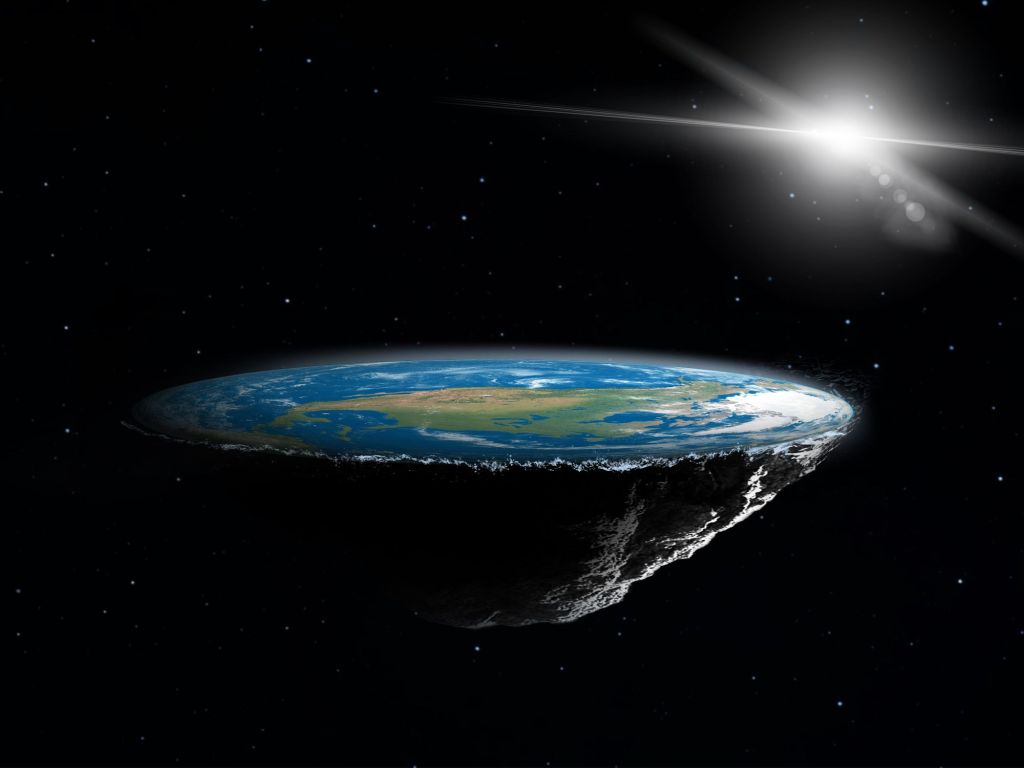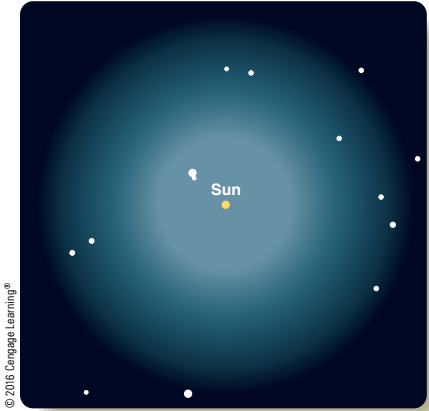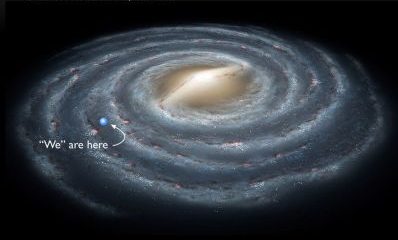
In the 4th century B. C. E. (Before Common Era), scientists believed the Earth was the center of the universe. Before that, they were convinced the Earth was flat.
Now, most of us know that the Earth is not the center of the universe—nor is it flat. (Although there are definitely those who still believe we live atop a flat disk world, hurtling upwards through space.)
Not only is the Earth not the center of the universe, neither is the sun—and it’s not even the exact center of our solar system (you can read more on that here).
And if we zoomed out much farther and took a look at our galaxy from above—or below, take your pick—we’d find that the sun is not even near the center of its own galaxy.
It is, in fact, located in a small “spur” of stars just off one of the spiraling arms of the galaxy. And if our universe is in fact infinite—as the prevailing theory describes—then there can’t even be a center, so our galaxy is not the center of anything.
But what does all of this mean? Where exactly are we in the universe?
I presume you’re familiar with your home address. If you don’t have it memorized, you at least know you live in a certain house, on a certain street, in a certain part of town.
Where are you right now? Let’s say you’re outside, enjoying some midday sun. Let’s imagine there’s a drone flying over you—your neighbor’s kid annoying the community again.
It takes a picture that includes you and an area about fifty feet across. In the picture, you’re visible—and about a centimeter tall.
Now, let’s pull back a bit farther.

You’re somewhere in this image. Maybe enjoying some of the nature that’s kept a foothold amidst the suburban development. Maybe you’re sitting outside your house. Wherever you are—we can’t see you anymore.
Now we’re going to pull back even farther, but before we do, we need to make sure to transition over to the metric system (if you don’t use it already!).
Not only does the majority of the world use it, it’s really easy to make conversions. So scientists—even American scientists—use it too. Our current field of view is about 1 kilometer across.
Let’s expand that by a factor of 100. A patch of land about 100 km across is going to look something like this.

In case you’re curious, this is a view of Southern California. And as you’ve probably noticed, you definitely can’t see any people from this high up.
Ready to zoom out even farther?
Awesome! Let’s pull back by another factor of 100.

Whoa…that got really far really fast.
This screenshot from Google Maps shows a space roughly 10,000km across—I say “roughly” because I made some very crude estimations involving the scale indicator and a folded piece of paper. But it closely matches what I see in Michael A Seeds’ Foundations of Astronomy textbook, so I’m gonna call it good enough.
Here’s the thing, though. To us little people, our planet seems huge…but this view of the Earth is still really zoomed in.
Ready to zoom out by another factor of 100?

Our field of view is now roughly 1,000,000 km across.
Now, though, even the metric system becomes a bit inconvenient to use. We’ve barely dipped our toes in the true expanse of the universe’s distances, and already we’re in the millions of kilometers.
For extremely large distances, astronomers use some truly extraordinary units—light-years and parsecs. But while we’re still in our own solar system, we’re just gonna use scientific notation to shorten the metric system. Our million-kilometer field of view will become 1 x 106 km.
Ready to pull back some more?

What’s up with that “1 AU” measurement, you ask? Well, that’s another way astronomers deal with the extraordinary distances in the universe—they make up their own units. 1 astronomical unit is the average distance between the Earth and the sun.
For those of you who still favor the imperial system, that’s 93 million miles.
Our field of view is now 100,000,000 km across, or 1 x 108 km. That’s 100 million kilometers. Our previous field of view fits in that tiny red box.
And we’re not done yet.
Next, we’ll pull out by another factor of 100—until we can see our entire solar system.

Well. I said we could see our whole solar system…and we kind of can. The Kuiper Belt, like the asteroid belt but icy objects instead of rocky ones, orbits beyond Neptune and isn’t shown here. And we can’t actually see the inner solar system, between the sun and Mars. It’s too tiny for that.
Holy cow, who ever thought we’d refer to the entire distance from the Sun to Mercury to Venus to Earth and straight on out to Mars as tiny?
And yet, that’s what it is. Our current field of view is 1 x 1010 km, 10 billion kilometers, and the entirety of our previews field of view fits inside the red square in the center.
Is your mind sufficiently blown…or would you like more?
Excellent! Let’s pull out to a field of view of 1 x 1012 km, or 1 trillion kilometers.

The entirety of our previous field of view fits in that little red square.
Yup. The sun and all the planets, the asteroid belt, all the dwarf planets (yes, including Pluto), all the smaller Kuiper Belt objects and everything surrounding our solar system in the hazy Oort Cloud—it’s all right there in that red square.
But…where’s all the stars?
I’ll show you.

Our field of view is now 1 x 1014 km. We are looking at a region of space 100 trillion kilometers across.
We can’t see the planets we know and love from here. They all fit inside the yellow dot that represents our sun.
Light takes a split second to hit the ground after leaving your flashlight. It takes four and one-third years to reach us from the nearest star.
Actually, that’s a unit of distance in itself, called a light-year. One light-year is the distance that light travels in one Earth year. It’s abbreviated as 1 ly.
Ready to zoom out again?

This is not actually a photograph of our stellar neighborhood because we’ve never sent a spacecraft out this far. But it does encompass a distance of 1 x 1016 km. That’s 10 quadrillion kilometers.
You know what, enough with the kilometers already. Ten quadrillion is getting just a little too much. Our field of view is roughly 1057 light-years.
What does that mean? Well, it’ll take light from any star on one side of the image about 1057 years to reach any star on the other side.
Yeah. I know. Kinda crazy. But we’re not done yet!

Our field of view now encompasses the Milky Way Galaxy, our home in the universe. It’s what we call a “barred spiral” about 80,000 ly in diameter. For those of you still used to the smaller units—that’s 7.6 x 1017 km!
The nature of our galaxy is a topic we’ll explore a great deal in future posts What makes it a spiral shape? Why is the center barred, rather than round? What’s it like in the center, and why are we where we are?
None of the answers to these questions are definitively known, but astronomers are getting a better picture every day.
We do know, however, that the Milky Way Galaxy is a great cloud of stars, gas, and dust held together by the combined gravity of all its matter. We can guess that there are anywhere from 100 billion to 400 billion stars.
You can see our galaxy for yourself if you go out to a dark place away from urban light and city haze. It’s that great, cloudy band of stars that traverses the night sky, and earned the name Milky Way.

If I’m to be more accurate, however, almost all the stars you can see in the sky are part of our galaxy, too. The cloudy band is just the thickest part. The exceptions are the other galaxies we can see, one even with the unaided eye.
So what about those other galaxies? How far away are they?
Time to expand our view by another factor of 100.

Meet our local group, a cluster of about a few dozen galaxies spread over a region of about 17 million light-years. That’s 1.6 x 1020 km—1 sextillion, 600 quintillion kilometers!
Now you see why astronomers use scientific notation and make up their own units of measurement?
But…what if I told you that we’re still not done?

I know. It looks more like luminous cobwebs than something you might see in space. But believe it or not, this view actually encompasses somewhere around 1 x 1021 km, or 106 million light-years.
Our local group is just one cluster among…well, millions, billions, trillions, who can know?
Each tiny point of light here is a whole galaxy tens of thousands of light-years in diameter and likely containing hundreds of billions of stars. They cluster together in larger superclusters and even larger filaments, those strand-like structures that web across the universe.
How did they form? Why did they form? Why are they the way they are?
These are questions astronomers are still puzzling over, but we’ll explore hypotheses, at the very least, in future posts.
Nicely written 🙂 If I remember correctly, the Catholic Church didn’t admit Galileo was right (and issue a papal pardon) until the 1960’s—after Yuri Gagarin had become the first man in space.
LikeLike
That sounds right. After Yuri went to space? I hadn’t heard about that…wow! The Catholic Church is stubborn!
LikeLiked by 1 person
We all are when we think we’re right.
LikeLike
Very true…unfortunately. Seems everyone who talks about climate science these days is convinced they’re right, for instance.
LikeLike